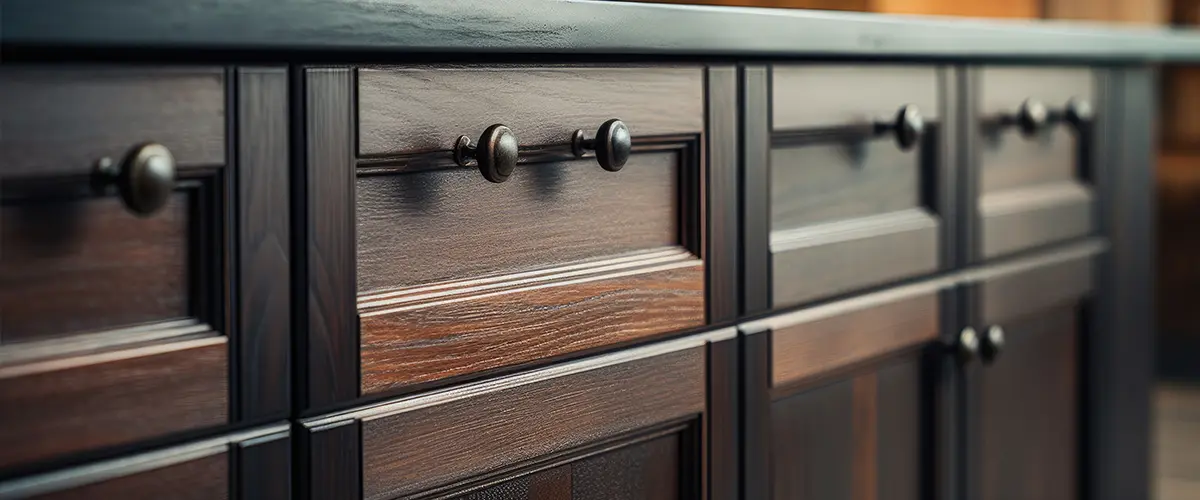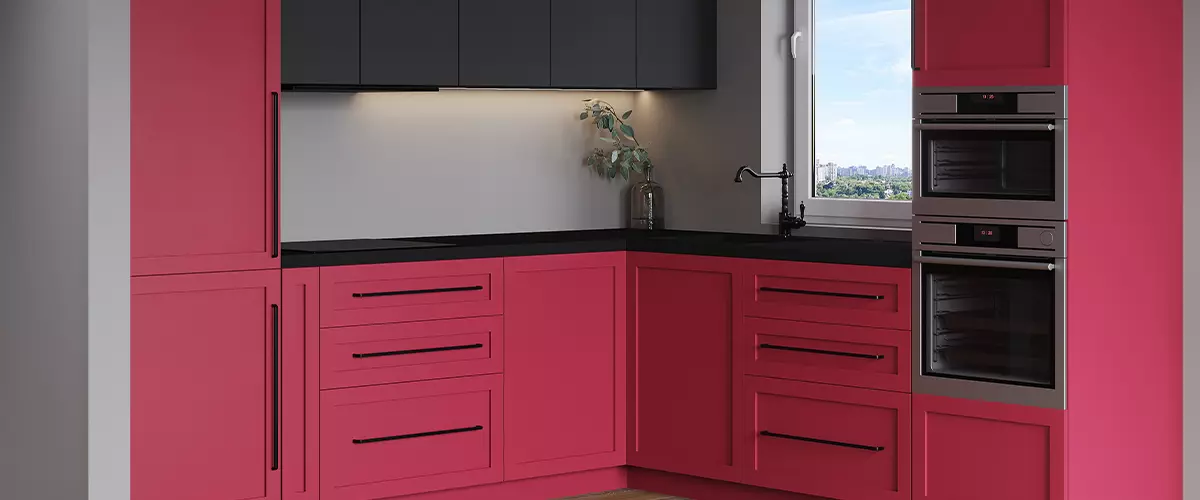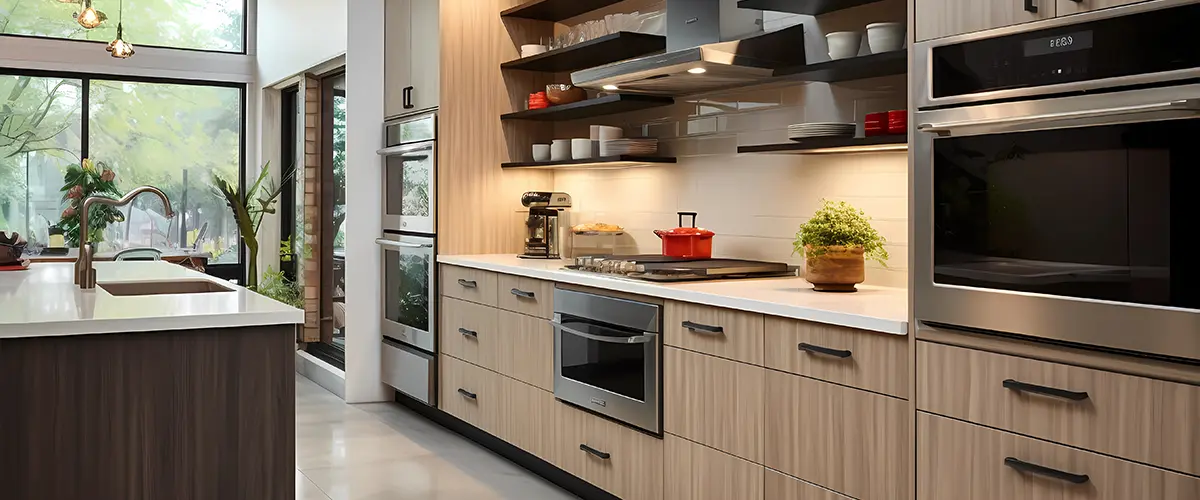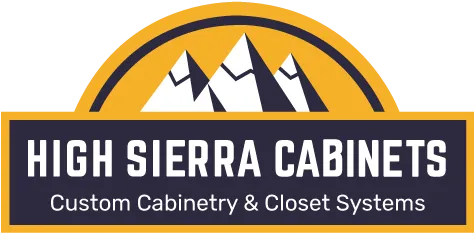Particle Board Vs MDF for Cabinets: Which is the Better Option?
Choosing the right material for your kitchen cabinets can feel overwhelming. One key choice is between particle board and medium-density fiberboard. This blog will guide you through deciding which one fits your needs best, comparing their strengths and weaknesses.
Deciding on the perfect material for your kitchen cabinets can be a daunting task amidst the plethora of options available.
High Sierra Cabinets is here to simplify this decision for you by comparing two popular choices: particle board and medium density fiberboard. This blog post delves into the nuances of both materials, providing you with the knowledge needed to choose the one that best suits your kitchen’s aesthetic and functional requirements.
Keep reading to make an informed choice!

Difference between Particle Board and MDF
Materials used (wood fibers, wood chips, solid wood)
Manufacturers create particle boards by combining wood chips, sawdust, and a synthetic resin or other suitable binder, which they then press into sheets.
These components are often sourced from leftover materials in the woodworking industry, making particle board an eco-friendly option for cabinet construction.
On the other hand, MDF (Medium Density Fiberboard) uses fine wood fibers instead of chips, providing a smoother surface that’s ideal for painting or applying veneers.
Solid wood represents a more traditional choice used in higher-end cabinetry due to its durability and natural beauty. Unlike engineered woods like particle board and MDF, solid wood comes directly from lumber and retains its natural grain patterns, adding character to cabinets.
Next up: exploring how these materials influence construction methods and cost differences.
Construction methods and cost differences
Making cabinets from particle board and MDF involves different processes due to the materials’ distinct natures. Particle board is made by compressing wood chips, sawdust, and resin binders under heat and pressure, making it a cost-effective option for kitchen cabinet boxes.
It’s generally cheaper to produce compared to MDF. On the other hand, MDF (Medium Density Fiberboard) requires finer wood fibers mixed with wax and resin binder that is then subjected to high temperature and pressure.
This results in a denser, heavier product that offers a smooth and flat surface ideal for applying wood veneer or paint (cabinet refinishing).
“The choice between particle board vs MDF for cabinets often boils down to balancing cost with desired quality.”
While both options present more affordable alternatives than hardwood plywood, the construction method of MDF inherently makes it slightly pricier than particle board.
The density of MDF also contributes to its stronger structure, making it better suited for heavy-duty use such as door panels and shelves within cabinets where durability is key.
Pros and Cons of Using Particle Board for Cabinets
- Cost-effective option
Choosing particle board for cabinets can save you money. This material costs less because it uses wood chips and resin, which are cheaper than the materials used in MDF or solid wood products.
It makes particle board an attractive option for those on a budget who still desire to upgrade their home’s appearance without spending too much.
Using particle board allows homeowners to invest in other aspects of their renovation projects. With its affordable price, you get the chance to allocate funds elsewhere, like new appliances or countertops, making your overall project more manageable financially.
This approach provides both functionality and style without breaking the bank.
- Less durable than other materials
Particle board is less durable than other materials, making it vulnerable to dents and scratches over time. Prolonged exposure to moisture can also cause particle board cabinets to swell or warp, potentially leading to structural issues.
While it is a cost-effective option, its durability should be considered when deciding on cabinet materials.
“When choosing cabinet materials, durability plays a crucial role in ensuring long-term functionality and aesthetics.”
- Can be prone to water damage
Particle board is less durable than other materials and can be prone to water damage. When exposed to moisture, particle board swells and warps, causing irreversible damage.
This susceptibility makes it less suitable for areas with high humidity or frequent spills, as water exposure can compromise the structural integrity of cabinets made from this material.
MDF, on the other hand, has a denser composition which allows it to resist water damage better than particle board. While both materials are susceptible to swelling when exposed to excessive moisture, MDF typically holds up better in damp conditions due to its finer particles and denser structure.

Pros and Cons of Using MDF for Cabinets
- Smooth and flat surface
MDF boasts a smooth and flat surface, making it an ideal choice for cabinets with veneers. The even texture of MDF allows for a uniform finish when painted or laminated, providing a sleek and polished look to your cabinets.
Additionally, the stability and lack of grain in MDF ensure that it resists warping or cracking better than solid wood, maintaining its smooth surface over time.
Particle board, on the other hand, may not offer the same level of smoothness due to its coarser composition. While it can still be used for cabinet construction, achieving a truly flat and seamless appearance may require more effort during finishing processes.
- Better for cabinets with veneers
MDF, known for its smooth and flat surface, is better suited for cabinets with veneers. The dense composition of MDF provides a stable base for veneer applications, ensuring a high-quality finish.
The uniformity and lack of natural knots found in solid wood make MDF an ideal choice for achieving a flawless look when applying veneers.
- Heavier and stronger than particle board
Conclusion: Which Material is Best for Cabinets?
The Verdict on Your Kitchen Cabinets: Particle Board or MDF?
In the quest for the ideal kitchen cabinets, the choice between particle board and MDF hinges on a delicate balance of durability, cost-effectiveness, aesthetic preferences, and environmental considerations.
Whether your priority lies in budget-friendly solutions without compromising style or in enduring strength and a flawless finish, the decision ultimately circles back to your unique needs and lifestyle demands.
We encourage you to reflect on the factors discussed, from functionality and maintenance to environmental impact and aesthetic value, as these will be instrumental in guiding your selection process.
Recommendation based on your needs
When selecting the best material for your cabinets, it’s crucial to consider factors such as durability, functionality, aesthetic appeal, maintenance, budget, weight and environmental impact.
If you prioritize a more cost-effective option with low susceptibility to water damage, particle board might be suitable for your needs. On the other hand, if you prefer a stronger and smoother surface that is better suited for veneers and a higher level of durability overall, MDF could be the ideal choice.
Your decision should align with your specific requirements in terms of usage and longevity.

Particle Board VS MDF for cabinets - FAQs
Make The Right Choice For Your Home
Ready to transform your kitchen with cabinets that blend seamlessly with your lifestyle and decor?
Contact High Sierra Cabinets today to explore our diverse range of options and find the perfect match for your home. Let us help you create a kitchen that’s not only functional but also a reflection of your taste and elegance. (775) 242-6832
